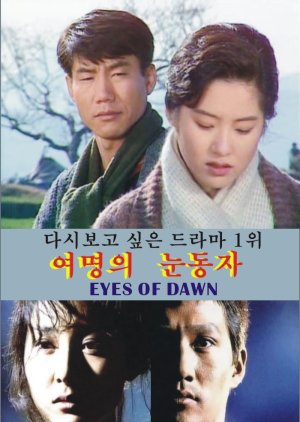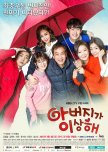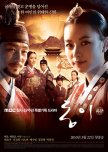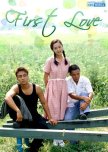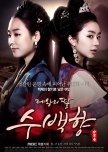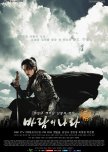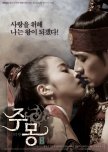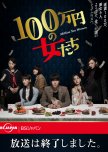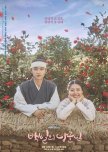
This review may contain spoilers
A story full of humanity in the face + despite blatant inhumanity. An epic about love & compassion
"Eyes of Dawn" marks a quite spectacular milestone for South Korea Television Series as well as the kick off for a new era of TV production – ambitious in terms of time sensitive content as well as an artistically valuable approach. The production dates back to 1991… South Korean life is just cautiously starting to be a bit less suppressed."Eyes of Dawn" is the creative script and cinematic processing of a novel, which deals with the tragic relationships of the three protagonists Choi Dae-chi, Yoon Yeo-ok and Jang Ha-rim as well as the bitter history of their time. The story takes place during the Japanese colonial rule, during the last years of the second world war and reaches up to the liberation of Korea and the time of the Korean War.
The KDrama begins its story during the last years of World War II – with Yeo-ok, a comfort woman, who like cattle is being shipped to northern Manchuria, and Ha-rim, who is drafted into the military as a student. Yeo-ok meets and falls in love with soldier Dae-chi, while serving as a comfort woman for his Kwantung Army unit. (With Ha-rim she only meets much later. )The world war and the subsequent struggle in Korea for a new political identity grind the three protagonists mercilessly through somewhat traumatizing mills. Love and passion accompany the three on their dramatically entangled paths, where they sometimes meet, sometimes separate, meet again and separate again within the turbulent swell of their time. Showdown is during the Korean War at Jirisan Mountain – in the ´eyes of dawn´…
For this KDrama MBC spent a lot of money – more than 5 times as much, compared to other TV series. It was shot at original or similarly exotic locations abroad. (If you like, see also the side notes below.) The project feels more like an approx. 36-hours-long movie. With "Eyes of Dawn" MBC celebrated its 30th anniversary with a bang, so to speak. The KDrama was enthusiastically received by the audience. For director Kim Jong-hak, "Eyes of Dawn" was the breakthrough. The former journalist came to MBC in 1977 and worked his way up the ranks with historical dramas in a politically turbulent time full of rapid changes (in series production, too). However, "Eyes of Dawn" is his first truly self-responsible of two innovative, groundbreaking masterpieces (the other being "Sandglass"). Thus, Kim has unsparingly reappraised the latest history of his country and his compatriots with a confident original signature and thorough, artitistic determination. At his side, screenwriter Song Ji-na provided a well-rounded, coherent script with depth and complexity. A team of talented actors and an intensely lingering soundtrack rounded off the ambitious projects with a high entertainment value.
Fantastic actors. The three leads in particular, but not just them. This applies to everyone else – there were an impressive 270 actors as well as around 21.000 supernumeraries involved...
"Eyes of Dawn" and "Sandglass" are actually both (in contrast, for example, to the younger KDrama "Faith or The Great Doctor", which Kim Jong-hak also had directed) reduced to the essentials when it comes to dialogues. Passionate, but also ruthless in the authenticity of sometimes ugly, even brutal details. Gross and austere, yet visually stunning, too. With selected camera angles that often say more than words, and scenes, that burn into your memory. The KDrama wants to show life as it was, back then... 'Nice' is rare. Sincere it is, though. Serious. A great piece of series culture. A dream of a historical drama, aiming at bringing history to consciousness in a memorable, authentic way. Thus, what happened is not forgotten. It is a cinematic monument: Take a look! Feel it! Recognize what happened! Estimate! (Too bad, it's not widely circulated with at least English subtitles... however, apparently there's a musical now... well... let´s hope.)
The story offers merciless insight into the suffering of the comfort women who, even as teenagers, were often brutally physically abused for the pleasure of the Japanese soldiers – a war crime that has not been adequately investigated and atoned for to this day. In principle, people of Chōsen were systematically oppressed back then. The Chōsen soldiers in the Japanese army, thus also had a particularly hard time, as the KDrama bluntly shows, too. And then there is the turmoil and ruthless brutality of diverse war sites in inhospitable locations around the Pacific Ocean, and later between brothers and sisters as the Korean Peninsula was coldly caught by the increasing Cold War. With the uprising on Jeju-do becoming part of the story, an up until then rarely discussed aspect of the late 1940s comes to mind. As well as another, often suppressed war crime that Japan had committed against its international prisoners in connection with Unit 731: mostly deadly ending medical experiments on several thousand men, women and children in one of the coldest places on earth, in northern Manchuria. (In case you didn´t know, you may see the side note below.)
But "Eyes of Dawn" is also a story full of humanity even in the face and despite all blatant inhumanity. An epic about love, friendship, connection and compassion. There were plenty of awards. I line up there. This KDrama production is particularly valuable…
(...especially from a historical point of view for me as a European. Although I did take history as an advanced course in school, I somehow had never considered a lot of these events and topics really seriously before. But even beyond its historically enlightening ambitions, "Eyes of Dawn" consistently and purposefully tells a powerful story about three (ordinary) people of their time and their tragic fates, complexly woven into an emotionally touching love triangle.
(For the sake of completeness: as this KDrama is from 1991, visual and acoustical quality obviously can´t be compared to recent standards...)
----------------------------------------
SIDE NOTE
--- Some background information on the Pacific War and the filming locations at the original historical locations ---
- War sites on the Chinese Mainland – Northern Manchuria
World War II began in Asia with Japan's invasion of China in 1937. The Second Sino-Japanese War was fought almost exclusively on the Chinese mainland until the end of 1941. Only with the Japanese attack on Pearl Harbour on December 7 in 1941 did it spread to the entire Pacific and had the US allies also intervening in the war against the massive Japanese expansionist policy. Thus, in the course of 1942, the balance of power shifted towards the USA. However, the warfare was difficult. The scenes of the battles were often in impassable swampy areas and rain forests, where tanks and heavy artillery could not be used. So there was a lot of fighting in the air and on the water. In November 1943, the Soviet Union also opposed Japan and opened a second front in Manchuria. The air for Japan was getting thinner and thinner. The army motivated their soldiers by employing 'comfort women', practically forcibly recruited from their colonies, who accompanied 'their' troops as sex slaves and had to ensure their good morale. Among them were minors, too (like the fictional Yeo-ok).
- In the jungles of Burma
In its large-scale campaign to conquer all of Southeast Asia, after the effective invasions of the Philippines, Indonesia and Malaysia, Japan was also able to take Burma in the spring of 1942. China was thus cut off from supplies. Starting from Ledo in British-Indian Assam, the USA had an extra supply road built through Burma's jungle – the "Ledo Road". In the meantime, the Japanese troops were pushing the British further and further back into the north of Burma, ultimately driving them out of the country for good and even pushing forward into India in a further offensive. The Japanese army had now themselves fallen victim to the lack of replenishment with supplies. They originally only had food for three weeks. After that they had to see for themselves. (These jungle fights become the operational area of the fictional Dae-chi.) In this context, in 1944 the fierce hand-to-hand combats at Imphal and Kohima south of Ledo marked a turning point in the course of the Second World War as the British reinforcements arrived just in time.
- Saipan: Strategically important Mariana island in the middle of the Pacific Ocean
In mid-June 1944, the US Marines landed on the south-west coast of Saipan in the bitter struggle for the strategically important island chain of the Mariana Islands in the Pacific Ocean. This also becomes the setting in "Eyes of Dawn", because Ha-rim is stationed in the field hospital here and Yeo-ok was also shipped there as a comfort woman.
Three weeks after the US Marines landed, the heavily fortified island with its three airfields was owned by the Americans. From here, the neighboring island of Tinian could also be taken, from where the atomic bombers in the direction of Hiroshima and Nagasaki actually started about a year later.
- From Liberation of Chōsen to Korean War
The Japanese surrender in 1945 was followed by the liberation of the Chōsen colony. Contrary to the Western view of this 'liberation' of Korea and the role of the USA in supporting/forcing a democratic South, which for me as a German is more Western, in "Eyes of Dawn" you get a non-Western portrayal. The post-colonial struggle of the people of Korean origin for their political sovereignty, previously stolen by Japan, began even before the (rest of the ) world recognized it as the Korean War in 1950. "Eyes of Dawn" portrays the time of the tussle between the USA, Russia and China on the one hand and the search for a new national Korean political identity on the other. The KDrama emphasizes this in a dramaturgically moving way using the example of the fatal triangular relationship between Dae-chi, Ha-rim and Yeo-ok in the back and forth of their pro- and anti-communist agent activities and in the service of the army of the newly installed Republic of Korea on the one hand and those who resist this government on the other partisan army on the other hand.
----------------------------------------
----------------------------------------
SIDE NOTE:
--- Jeju Uprising 1948/49 ---
A notable sequence in connection with the resistance against the US-sponsored Rhee government is the April 1948 to June 1949 uprising on Jeju Island. The KDrama had its scenes shot on location. Just consider, that at the time of the uprising almost every family on the island had probably lost someone, but for decades silence was officially decreed about this mass murder launched by their own (new South Korean) government. Surviving 'activists' were banned from working throughout South Korea. "Eyes of Dawn" is one of the first public confessions and the cautious approach to coming to terms with the past with regard to that dark first chapter of this young republic.
The USA categorically rejecting any kind of communist orientation regarding a political future as South Korea or all of Korea, were faced with plenty of riots and guerrilla actions in the course of the national resistance against an (yet again) unwanted paternalism. The uprising on Jeju Island is arguably one of the most shocking examples. After expressions of dissatisfaction with the planned elections for the US-sponsored government and resistance to renewed foreign rule, the population was ruthlessly massacred by the Korean army and the help of the US-Army´s occupying forces. The people fled to Hallasan mountain area while their coastal villages (270 out of 400) were destroyed. There is disagreement about the number of actual casualty – the numbers vary between 27.000 and 140.000.
In 1991, when "Eyes of Dawn" was broadcast, this topic had not yet been officially dealt with – but with this KDrama the uprising got an unmistakable voice and recognition for the first time. It was not until 1999 that the government convened a thorough investigation. In 2006, the government officially apologized. However, police and the Department of Defense only came up with an apology recently, in 2019.
-----------------------------------------------
------------------------------------------------
SIDE NOTE:
--- Region of Harbin in northern Manchuria and Unit 731 of the Japanese Kwantung Army, which experimented with biological and chemical weapons on humans and then used those on civilians as well ---
Japan had already secured influence in northern Manchuria during the course of the first Sino-Japanese War by building the South Manchurian Railway. The valuable raw materials mined here were transported to Chōsen and shipped from there to Japan. The railway was under the protection of the Japanese Kwantung Army. Between the first two world wars, Russia, Japan and China fought for supremacy in Manchuria. Eventually, with the Japanese occupation of this economically viable region in 1932, they established the puppet state of Manchukuo, with Harbin being its largest city. Here was the stronghold where Unit 731, led by Ishii Shirō, began their spooky experiments. At last, after the end of war, between 1945 and 1948, the Communist People's Liberation Army, strengthened by its anti-Japanese resistance concentrated its forces in Manchuria.
Surgeon General Ishii Shirō and his Unit 731 were busy starting 1932 in and around Harbin with experiments on living people. Around 3.000 mostly bacteriologists worked for Unit 731. An estimated 3.500 mostly Korean and Chinese civilians as well as Soviet prisoners of war were victims of their cruel human experiments.
The experiments of the Imperial Japanese Army's secret Kwantung Army Unit 731, disguised as the "Department of Epidemic Prevention and Water Supply Department" laid the groundwork for a wide variety of horrific war crimes during World War II. Among this ´research´, for example, were investigations concerning varying effects of grenades on the human body depending on distance and position, investigations into the effects of bombs filled with a variation of bacterial powders, of pest bacteria or anthrax bacteria, or bombs filled with fleas being contained by such bacteria. It has been proven that Chinese prisoners of war were given food that was deliberately contaminated with typhoid pathogens. During the final years of the war, around 130 kg of anthrax warfare produced by Unit 731 was used to contaminate lakes, rivers and wells on enemy soil. Finally US prisoners of war were 1943ff used for experiments of Unit 731, too. E.g., for research about the susceptibility of 'white' people to epidemics. During the course of the war, another tens of thousands of mostly civilians died from rat induced epidemics of plague, of anthrax and of typhoid pathogens as a result of ´field research´ and by the use of thus produced biological weapons, based on the 'medical research' in Harbin.
And for further information:
Unit 731 always had the full support of later Japanese prime ministers, and the Japanese imperial family was aware of it, too.
The main perpetrators of Unit 731, including Ishii Shirō himself, ultimately remained unpunished after the war crimes trials – in exchange for the research results that they handed over to the USA.
----------------------------------------------------
Was this review helpful to you?

A tough one to get through....
Misery stemmed from uncontrollable oppression is justifiable but self-inflicting misery is questionable and down right annoying and exhausting to sympathize with, which this drama absolutely love to slap the viewers with. Needless to say, the writing is definitely not its strongest suit. Still an attractive piece from the 90s. Korean production was still primitive compared to the pioneers at the time, and this drama was amongst the first big breakthroughs. Which makes me wonder why wasn't it remastered yet despite being a significant piece.Was this review helpful to you?

Um Clássico Épico Coreano Sem Igual
"Eyes of Dawn" (Olhos da Aurora), lançado em 1991 pela MBC, é um drama histórico épico que se destaca como uma das produções mais icônicas da televisão sul-coreana. Ambientado em um período turbulento da história coreana, que abrange a ocupação japonesa, a Segunda Guerra Mundial e a Guerra da Coreia, o drama apresenta uma narrativa rica e complexa que explora temas de amor, sacrifício, e resistência.Qualidade de Produção e Narrativa
A série é notável pela sua impressionante escala de produção, o que é particularmente notável para um drama dos anos 90. A direção é habilidosa, capturando com autenticidade o sofrimento e a resiliência dos personagens em meio às adversidades históricas. A cinematografia é igualmente poderosa, com cenas que variam de batalhas intensas a momentos íntimos e emocionais, mostrando a versatilidade do elenco e da equipe de produção.
Personagens e Atuação
Os personagens de "Eyes of Dawn" são multifacetados, cada um trazendo uma perspectiva única sobre a guerra e suas consequências. As atuações são excepcionais, com os atores principais entregando performances que capturam a essência de seus personagens, imbuindo-os com profundidade e humanidade. As emoções são cruas e genuínas, o que facilita uma conexão profunda com o público.
Temas e Impacto
Sem revelar detalhes específicos da trama, "Eyes of Dawn" aborda temas universais que ressoam ainda hoje: a luta pela liberdade, a dor da perda, e a busca por redenção. É um drama que não apenas narra uma história, mas também convida o espectador a refletir sobre os horrores da guerra e o valor da paz e da solidariedade humana.
Conclusão
"Eyes of Dawn" é uma obra-prima que continua a ser relevante décadas após sua estreia. Com sua narrativa envolvente, personagens memoráveis e um olhar sincero sobre um capítulo doloroso da história coreana, este drama é essencial para qualquer entusiasta da televisão coreana ou do gênero histórico. Se você está à procura de uma série que oferece tanto entretenimento quanto reflexão profunda, "Eyes of Dawn" é uma escolha imperdível.
Was this review helpful to you?

 1
1